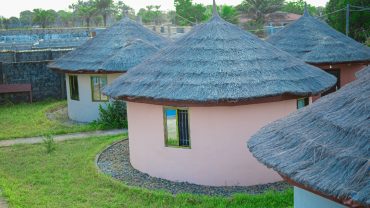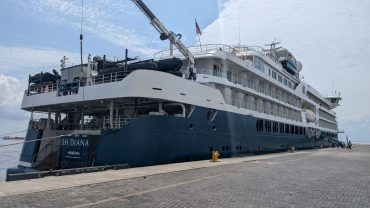It is no secret that the travel, tourism and hospitality industry has been decimated by the impact of the coronavirus COVID-19 outbreak. Even though spared the worst of the pandemic, Sierra Leone has been no exception. The Coronavirus (Covid-19) pandemic has been a nightmare for all and tremendously affected people’s livelihood, health, and social activities. Like all other countries, Sierra Leone succumbed and measures were instituted in curtailing the spread of the disease.
Sierra Leone registered its first Covid-19 case in March 2021 after which Lungi International Airport was shut and all policies and preventive measures have been geared towards promoting social distancing. As a travel business this was a nightmare. We were forced to let go of staff and the majority of time was now spent in our respective homes, watching the nightmare unfold on our screens. We reflected on how we could keep ourselves active, satisfy our appetite for travel, social activities and exploration while respecting the anti-covid measures.
We realized that one of the key opportunities of the pandemic was an increased consciousness that people need to look after their physical and mental well-being. It is well documented that both traveling and exercise has great benefits for our mindsets. It disconnects us from our daily lives and opens our horizons by allowing us to experience completely different cultures and live incredible adventures. This is why we started doing more hikes. Great for our mental health, great physical exercise all while promoting domestic tourism.
These are accounts of some of the walks and hikes that we have been doing in the last 12 months. Some are free (turn up and walk) and some are, well.. More challenging than others. See photos below!
LEICESTER PEAK
Leicester Peak is a peak located in Western Area, Sierra Leone. The estimated terrain elevation above sea level is 564 meters. With a rich panoramic view covering the capital’s most important and finest buildings, Leicester Peak is highly regarded by tourists as the ‘Beverly Hills’ of Freetown owing to the topography of the land. For most Freetonians, this place serves a host of purposes such as a ground to get a quiet moment, worship, party, ‘chill’ and even enjoy romance.
This trek starts at Bottom Mango, Wilberforce, founded in 1810 and was home to liberated enslaved Africans who had been brought to Freetown by the British Royal Navy West Africa Squadron. Giving a 10 minutes allowance for latecomers, at 7:10 am we are off. Hiking to Leicester Peak junction, you get to walk past some historical buildings, the Military barracks, State Lodge, National Telecommunication (Natcom), and other prominent buildings.
Arriving at Leicester Peak junction roughly 45 minutes later (depending on your speed), you are sure to feel a bit calm and relaxed as you trek through to the face of the Embassy of the United States. At this point, you take your final turn and prepare for a whole new challenge. An area once covered with greeneries is now occupied with massive mansions (some still under construction).
Reaching the top of the hill after a few twists and turns gives a great sense of fulfillment and even more chilled when feeling the fresh and friendly air and; the view makes the experience quite rewarding. After spending some time catching our breath we retrace our steps back to Bottom Mango and we are sure all your fitbit targets would have been smashed on this day.
DUBLIN TO RICKETT (BANANA ISLAND)
The Dublin to Rickett Hike is a whole day complete package experience. The hike itself is only a couple of hours, but the experience starts from being transported from Freetown through the historic Hillside villages and Grafton before turning off at Waterloo to hit the Peninsula road for Kent. The guide will narrate the history behind the oldest towns along the route.
Once you get to Kent, get ready for another mode of transport as we board wooden motor boats for the 25 minute crossing to Banana Island. Wave to fishermen who pass by as you make your way.
The water is usually calm so take the time to soak in the beauty of your surroundings, and a moment to let it all in if you are a first time visitor to the island. Due to time limitations we will not be able to do a tour of Dublin, as we will almost immediately head out for Rickett. Once you are at the end of Dublin you will come to a walkway made out of rocks apparently laid by slaves. It is never submerged in water and is referred to as “The bridge” – connecting the two islands into one people.
The walk is not difficult and will take about 2 hours. It is mostly flat, but as with all forest hikes, look out for vines, stumps, rotten trees and any slippery slopes. The trail runs very close to the coastline, so expect to catch glimpses of the sea, often an inspiration to keep going. The inhabitants of Rickett will be happy to meet you as it is a less tourist traffic than Dublin and you might also be able to get an audience with the headman/woman of the village.
After brief introductions and welcomes, we will return to Dublin via boat, allowing you to appreciate the full splendor of Rickett from the sea. It is more mountainous and hosts Simpson Hill, the tallest peak on the Island. This journey back will take an hour give or take and will get you back to Dublin in time for a full buffet lunch and a bit of a swim. As a note of caution, please be cautious when swimming in this area at Dublin as it is quite rocky and you can get easily cut.
After lunch and banter, we get ready to embark on the reverse journey, leaving the island behind but already planning a return to this enigmatic island just 25 minutes from mainland Freetown.
MAMBO WATERFALLS
The Mambo waterfall is an instant charmer for those who love to hike, those who love adventure, and those who would want to take a quick break from the hustles and bustles of the urban lifestyle. It is totally doable and child friendly too. Located on the other side of a downward slope in the mountains of the Mambo community, it’ll take a solid but exhilarating journey through an uneven stair of hills to reach that spectacular validation of nature’s incredible craft.
The hike targets those who wish to stretch their muscles through challenging long walks. At 7:30 those determined to take on the challenge arrive at Hamilton Junction where the walk to the fall starts. Either consciously or subconsciously almost every group of people was adhering to the social distancing measures.
The journey takes us through verses of an exciting walk on the highway of the Hamilton and Mambo community. Some of us bathe in the cool morning winds of the mountainous peninsula while cars race by and onlookers stand afar, curiously watching at the unusual parade of people of different shades of race, age, and gender. The athletic diversity of the group was evenly balanced. Some strolled unhurried and quiet, with music in their ears or having a chatter, others had their feet walking at an alarming pace while those with athletic prowess were virtually racing to the fall. Over a thousand steps into the walk, we approached a curve- it took us off the highway, at that moment, we began ascending the nerve-wracking hillside of Mambo. The path leading to the fall is motorable up to a certain point. For those who would want to visit the fall but do not want to take on the challenging hike, that is a win.
In just under 30 minutes or more, some of us reached the top of the main mountain that one has to conquer to reach the fall. Drenched in sweat and exhaustion, we stayed there for a brief while to catch a breath. When we look down, that position offered us this beguiling God’s eye view of the entire Mambo community. We could see how the vastness of the ocean projects its blueness and how the sea waves crash into the beach as if to embrace the shores. We saw how human settlement had progressed into nature’s cloak but still, a significant amount of lush vegetation remains in the community and beyond.
The last length to the fall is a descending walk we took through what’s left of the shallow jungle that is now dominated by sparse human trails. As we disembark the slope, with sore muscles and racing heartthrob, we began to hear the alluring symphony flying into the air when the stream of water musically glides down the rocks. In what seems like no time, we gazed upon the Mambo Waterfall- for some of us, it was our very first time, and behold, all the pain we incurred from the exhausting trekking ceased to matter anymore. We were in the face of a scene so grand and electrifying that I thought, even nature must have stopped and wondered, each time it glanced at such an astounding cascade of elegance.
From atop the cliff, where the water seems to flow, you could presume a single stream of water is feeding these chains of stairways that must have been etched on the rocks over time. As the gang of wild-frosted-water, in daring pageantry motion, cascaded these naturally enthralled stairways. You could almost feel, taste, and smell the astral gesture of imperial beauty that is riddled in such a melodramatic sensation submerged in the face of the Mambo Waterfall.
At the foot of the waterfall, a pool harbored a body of water so reviving, cold and apparent that you could see the little fishes strolling about. When the water overflowed it dribbled down to another pool which formed a chain of pools, and with each pool more profound than the previous. As we buried our minds in the soothing ordeals of the Mambo fall, I imagined; the collective experience offered by this waterfall, no matter how long one basked in it, one will never say, I’ve had enough of it.
MT SUGARLOAF
This trek begins at Regent, one of the earliest Creole settlements outside of Freetown. An insightful tour of Regent’s history from our guide accompanies your initial ascent through the village’s historic landmarks. These include wooden Creole houses, built from 1812 onwards by liberated slaves from England, the U.S. and Nova Scotia; and Africa’s oldest stone church, St Charles Church, completed in 1816. Leaving Regent, the hike begins for real as you dive into the shade of the rainforest that forms such a beautiful cloak around Sugar Loaf Mountain.
Beginning to climb steeply, layered canopies of trees arch their way above you, punctured by shards of light that entice you onto the open-air of the peak.
Twice en route – the first time after 45 minutes of walking, the second about half anAn hour later – you emerge from the forest for short intervals onto volcanic-formed rocky slopes. Catch your breath at each and turn around to marvel at spellbinding views of Freetown, soaking in not just the incredible panorama, but the change of perspective that the tranquillity and greenery of Sugar Loaf lend to the capital.
Ten minutes on from the second stop you will reach the peak, at first sight, an open circle enclosed by trees with a little view at all. It is hiding a secret. Walk around the left-hand side to a gap in the foliage, take a few steps down, and gaze across the heart of the Western Area Forest Reserve in all its grandeur.
Local knowledge: For one-day each year the tranquillity of Sugar Loaf is interrupted. On Independence Day, 27th April, an ascent of the mountain becomes a joyful celebration of Salone culture. On this day we make the climb complete with ample food, beer, poyo and sound system, to party the day – and night – away.
On any day, look, too, for the live Sugarloaf ‘bia bia’ (beard) growing happily on some of the trees. Unlike most trails in Sierra Leone, Sugar Loaf is fairly well marked. However, if you want to attempt Sugar Loaf alone, be aware that you will be expected to seek out a local guide and make a contribution to the local community before starting the ascent. This is covered in the cost of VSL Travel’s hike.
PICKETT HILL
All you need to know to conquer the Western Area’s most challenging hike.
Picket Hill is not a hill, but the highest mountain in the Western Area Peninsula, the region where Freetown and many of Salone’s finest beaches are located. It is ideal for those who fancy a test of humanity and can keep on marching to the sweet promise of a stunning view.
What is Picket Hill?
This 880-meter high mountain is located right in the middle of the Western Area Peninsula Forest, a 17.000 acres large national park that stretches along the mountains and the coast. Two routes will lead to the top; from Koba Wata and Big Wata, both at opposite sides of the peninsula. To cross from one end to the other leaves you with a 14k hike that can last between 6 and 8 hours total.
The Hike
Starting off at either Koba Wata or Big Wata, the hike follows the former trade routes that date back to the fifteenth century. In fact, from Koba Wata up to Masophe, the route follows the development of Koba Wata. The original villagers had settled deep into the forest, moving further down due to land exhaustion. The only thing hinting towards the existence of these former settlements are rusty information boards with faded names and descriptions.
The 3.5 hour ascent goes along a narrow, rocky trail through varying landscapes. At times the path is clear, and moving through the forest comes with ease. And at other times, well, less easy. Expect to use your hands and feet to climb slippery rocks, avoid vines hanging from massive trees and ward off swaying twigs as the local guide slashes his way through dense greenery.
Sounds gnarly? It is somewhat. But after a good hour of hiking, something quite magnificent happens. The senses turn sharper and the many greens of the forest become more vivid, the bird-cries have more clarity, and respect for the locals grow as you find out that some people walk this trail a couple of times a week.
Why? To avoid the official routes. After some time of dense foliage, a clearing offers two dramatic views. One shows the top of Picket Hill in the distance- seeming impossibly steep. The other shows a valley where a local specialty is being cultivated. A green specialty whose aroma’s might remind the naughtier traveler of certain shops in Amsterdam. A secret trade, strangely juxtaposed against the tranquil surroundings.
The top
Oh, how satisfying after such exercise. Wide and majestic, the peninsula shows off all its tricks in a dramatic play of mountain, sea, city, and river. Massive black rocks with flowers growing in between cracks offer the perfect picnic location. Muscles warming in the afternoon sun whilst the wind is the only sound to be heard.
It takes a 45-minute drive, a 3.5-hour hike, and steady determination to leave behind the bustling city and instead indulges in forest tranquillity topped with an astonishing view. This is where Sierra Leone gains an advantage; having mountains drop into the sea is unique. To add to that, the complete desolation during this hike shows that these trails are unexplored by tourists. You’ll be one of the few who can say. “I conquered Picket Hill.”
Read our full article about Pickett Hill.
With thanks to Muctaru Rogers, Esther Kamara and Kemurl Fofanah for contributing articles to this post.




Comment (0)